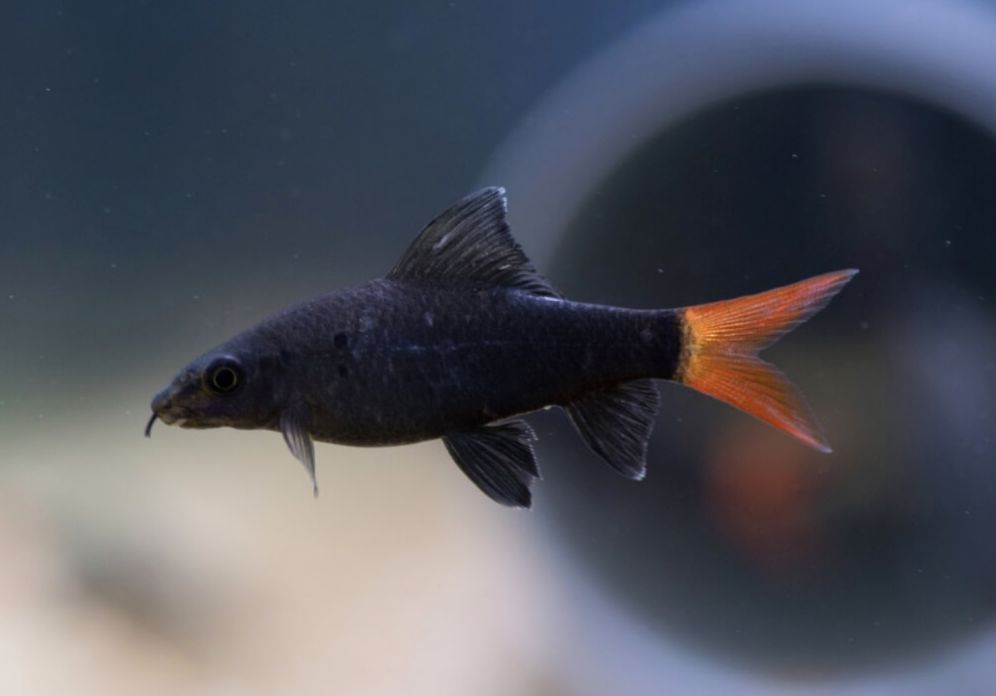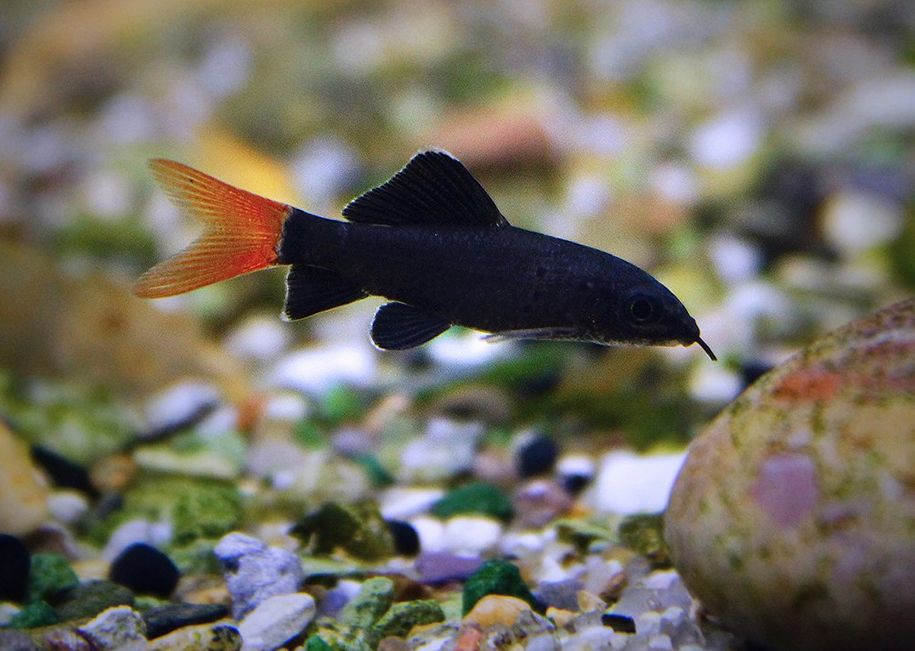The red tail shark (Epalzeorhynchos bicolor) is a striking freshwater fish from the Cyprinidae family, known for its bold personality and unique appearance. Due to its aggressive tendencies, it is unsuitable for community tanks, as it may harass or bully other tank mates, especially smaller or more peaceful species. Despite this, the red tail shark is a hardy, undemanding fish that appeals to many aquarists. Its sleek, almost entirely black body is dramatically accented by a vivid red tail, making it a standout addition to larger, well-planned aquariums where it can thrive without conflict.

Contents
Habitat in the wild
The red tail shark (Epalzeorhynchos bicolor), despite its name, is not a true shark but belongs to the Cyprinidae family, which includes various carps and minnows. This species is part of the Labeoninae subfamily, a group of barb-like fish.
In the wild, red tail sharks are native to Thailand, inhabiting shallow, algae-rich ponds and clean, slow-moving rivers such as tributaries of the Chao Phraya and Mekong rivers. These environments feature dense vegetation and rocky substrates, offering plenty of hiding spots for red tail sharks to establish territories. However, much of their specific natural habitat remains poorly documented.
Unfortunately, the population of red tail sharks in the wild has sharply declined. While the aquarium trade plays a role in this reduction, the primary cause is believed to be environmental degradation, including dam construction and wetland reclamation. These human activities have disrupted the species’ natural migration and spawning patterns, which were once driven by seasonal flooding. Consequently, the red tail shark is now considered nearly extinct in the wild.
Description
Size
In a home aquarium, red tail sharks typically reach a length of around 4 to 6 inches (10 to 15 centimeters). However, in the wild, where they have access to more space and natural food sources, they can sometimes grow a bit larger. Factors like water quality, diet, and tank size in captivity can influence their growth, making it essential for aquarists to provide optimal conditions to help them thrive.
Lifespan
The average lifespan of a red tail shark in a well-maintained aquarium is typically between 5 and 8 years. With optimal care, however, some individuals may live even longer, sometimes reaching 10 years or more. Several factors can significantly influence their lifespan, including water quality, a balanced diet, adequate tank size, and minimizing stress. To help your red tail shark thrive, provide clean, well-filtered water, offer a varied diet rich in proteins, and ensure the tank is spacious with plenty of hiding spots to reduce aggression. Maintaining a stable, peaceful environment will support their long-term health and longevity.
Body
The red tail shark has a slim, elongated body that is slightly flattened from the sides, with a curved back that gives it a sleek profile. Its small head features large, striking red eyes. The fish’s mouth, located on the underside, is cup-shaped and equipped with two pairs of barbels and setules. These specialized structures help the red tail shark scrape algae and other small organisms from the substrate, making it a useful cleaner in the aquarium.
Coloring
The red tail shark’s body is a deep, velvet black, giving it a striking contrast against its bright red tail. Its large fins are also black, with the dorsal fin standing tall and pointed, while the anal, abdominal, and pectoral fins are transparent and well-developed. The long, bifurcated tail fin, a vivid red, adds a bold splash of color, making the fish especially eye-catching in any aquarium.
| Characteristic | Description |
|---|---|
| Scientific Name | Epalzeorhynchos bicolor |
| Common Name | Red Tail Shark, Redtail Sharkminnow |
| Family | Cyprinidae (carp and minnow family) |
| Habitat | Freshwater rivers and streams in Southeast Asia |
| Size | Up to 6 inches (15 cm) in length |
| Lifespan | 5 to 8 years in captivity |
| Appearance | Deep black body with a bright red or orange tail fin |
| Behavior | Can be territorial and aggressive, especially towards its own kind |
| Diet | Omnivorous – eats algae, small crustaceans, and fish flakes or pellets |
| Tank Requirements | Requires a well-oxygenated tank with hiding spots and plenty of swimming space |
| Tank Size | At least 30 gallons for a single individual |
| Compatibility | Avoid keeping with other territorial or fin-nipping fish |
| Temperature Range | 72°F to 79°F (22°C to 26°C) |
| pH Range | 6.5 to 7.5 |
| Water Hardness | 5 to 12 dGH |
| Breeding | Difficult to breed in captivity |
| Conservation Status* | Not listed on the IUCN Red List (as of September 2021) |

Difficulties in keeping
Caring for a red tail shark isn’t overly difficult, but due to its large size and aggressive temperament, it’s not a good choice for beginners. This fish should be housed in a spacious tank, as smaller tanks can exacerbate its territorial behavior. A well-maintained, larger aquarium is essential for keeping the red tail shark healthy and reducing its aggression toward other tank mates.

Care and keeping in a tank
Tank size
The red tail shark requires a spacious aquarium to thrive, with a minimum tank size of 30 gallons (113 liters) for a single fish. This space is essential for swimming and establishing territory. Red tail sharks are known for their territorial and aggressive behavior, especially toward similar-looking fish, so it’s generally best to keep only one in a tank. Housing more than one would require significantly more space to reduce conflicts.
When setting up the aquarium, include plenty of hiding spots, such as driftwood, rocks, and artificial plants, which help reduce stress.
Tank decor
While the red tail shark needs plenty of hiding places, it isn’t particularly demanding when it comes to tank decorations and won’t harm soft-leaved plants. However, it’s recommended to recreate its natural habitat—a fast-flowing river with a substrate of varying sizes. Using gravel, stones, and pebbles for the substrate, along with adding tree roots and branches, can help mimic this environment.
Plants such as Microsorum, Bolbitis, or Anubias are ideal for this setup, as they can easily attach to the tank’s decorations. Bright lighting encourages algae growth, which is a beneficial part of the red tail shark’s diet. Like other fish from fast-moving rivers, it thrives in clean, oxygen-rich water with moderate flow and cannot tolerate a buildup of organic waste.
Water parameters
The optimal water parameters for keeping a red tail shark are as follows:
Dissolved Oxygen: Ensure the water is well-oxygenated. Proper circulation, aeration, and surface movement are vital for maintaining adequate oxygen levels.
Temperature: 72°F to 79°F (22°C to 26°C). Red tail sharks thrive in tropical water temperatures within this range.
pH Level: 6.5 to 7.5. Maintain the aquarium water at a slightly acidic to slightly alkaline pH.
Water Hardness: 5 to 12 dGH (degrees of General Hardness). Aim for soft to moderately hard water, as this level is ideal for the fish’s health.
Ammonia and Nitrite: 0 ppm (parts per million). Both ammonia and nitrite are toxic, so it’s crucial to keep these levels at zero. Regular water testing and efficient filtration are essential for maintaining these parameters.
Nitrate: Below 20 ppm. While less toxic than ammonia and nitrite, elevated nitrate levels can still harm the fish. Regular water changes help keep nitrates in check.
Diet
In the wild, they are omnivores, with a significant portion of their diet consisting of algae and other plant matter. You might often observe them scraping algae from rocks in the tank, but they thrive on a varied diet that includes vegetable additives.
A suitable diet for a red tail shark should include:
- High-quality fish flakes or pellets: These should form the staple of their diet. Look for products designed for tropical fish that contain a mix of plant-based and protein-rich ingredients.
- Algae wafers or spirulina-based foods: Since red tail sharks naturally graze on algae, offering algae-based foods can support their health.
- Frozen or live foods: Occasionally supplement their diet with live or frozen options like brine shrimp, bloodworms, daphnia, and mosquito larvae for added protein and variety.
- Fresh vegetables: Red tail sharks enjoy vegetables like blanched zucchini, spinach, and cucumber. You can clip these to the side of the tank or weigh them down so the fish can nibble.
- Occasional treats: Small pieces of cooked fish or shrimp can be offered as treats, but these should not comprise the majority of their diet.
Tank mates
Though red-tailed shark is sold as a fish for community tanks, in fact, it isn’t so. However, it doesn’t mean that the fish should be kept separately; it just means that you should more carefully choose tank mates.
Juveniles are very timid and they tend to hide in some dark tank corners, while the adult species are rather territory dependent and behave aggressively towards their tank mates that look like them. Some species are more aggressive, than others.
You should exclude bottom dwelling fish (such as cichlids and the majority of catfish species) from the list of tank mates, since they may be attacked by the fish. To occupy upper water layer in the tank you should choose small active schooling fishes.
Ideally, it’s better to put red tail shark the last into the tank. Probably, in the wild this fish prefers solitary way of life and they get together only for spawning season. In captivity this instinct is preserved and it gets stronger, therefore it’s better to keep the adult alone.
In a very large tank with large number of hide-places it’s possible to keep several red tail shark species, however each fish will require at least 1 meter of the tank length.
Then who can get on well with red-tailed shark? These are characin and carp species, small and fast fishes. All these fishes are too fast for red tail shark to catch them and they inhabit in upper and middle water layers. For example: glowlight tetra, emperor tetra, rummy nose tetra, cardinal tetra, neon tetra.
Gender differences: male vs female
Distinguishing between male and female red tail sharks can be quite challenging, as they do not exhibit significant physical differences. Unlike some other fish species, there are no reliable external features or coloration patterns to differentiate the sexes.
As red tail sharks mature, males may develop slightly slimmer bodies, while females might appear rounder, especially when carrying eggs. However, these differences are subtle and often difficult to discern.
The best method to determine the sex of a red tail shark is through behavioral observations during the breeding season. Males tend to display more aggressive and territorial behaviors while establishing their territories and competing for mates. In contrast, females may exhibit behaviors related to egg-laying and parental care if they successfully spawn.
If you are interested in breeding, it’s advisable to purchase a group of young red tail sharks and observe their behaviors as they mature. This approach allows you to identify potential pairs or individuals displaying signs of breeding behavior.
However, if breeding is not your primary goal, it’s perfectly fine to keep a single red tail shark in an aquarium. These fish are generally territorial and may not thrive in groups. Ensure your tank setup provides adequate space, hiding spots, and optimal water quality, regardless of the fish’s sex
Breeding
As far as is known, red tail sharks do not breed in captivity in private tanks. Instead, they are bred on farms that often use hormones to facilitate reproduction. This method is believed to be essential for maintaining the population of red tail sharks in the wild.